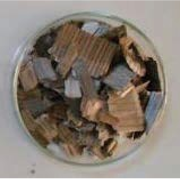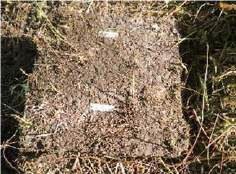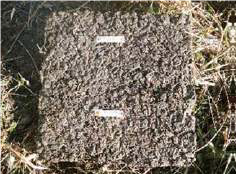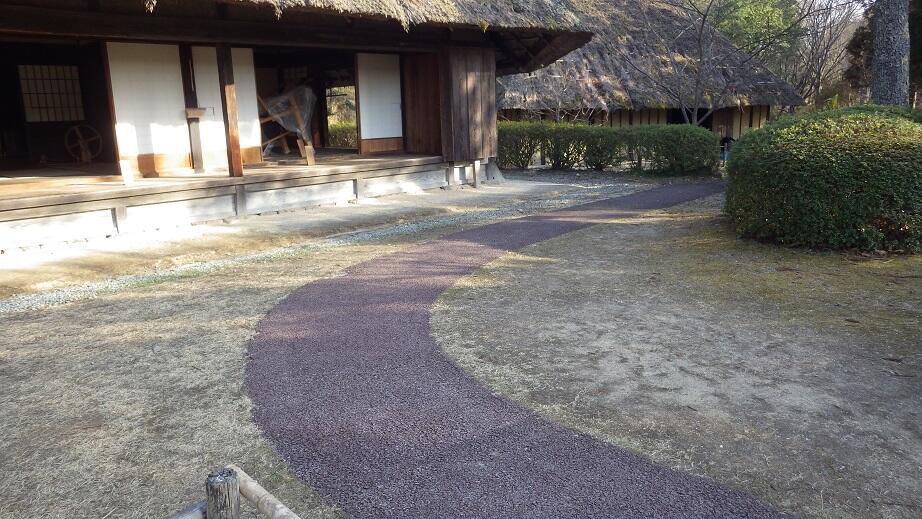Have you heard of wooden pavement material made by semi-carbonizing and hardening wood chips? It is a revolutionary paving material that is more durable than conventional wood pavement materials. The material was developed by the Forestry and Forest Products Research Institute. In comparison with asphalt pavement, wood pavement has better cushioning properties, making it more comfortable to walk on, and can also be used as fuel after use. Effective utilization of the unused wood resources that lie dormant in the local area can be expected to contribute to the development of local industries and the creation of jobs.
Overcoming the weaknesses of wood pavement materials by semi-carbonization
| Have you ever seen a pavement made by wood chips hardened with resin, etc. in a park or on a promenade? While this kind of wooden pavement is soft and easy to walk on, it has the problem of not lasting long as the wood chips peel off or rot. |  Fig.1 Semi-carbonized wood chips that have turned black (Provided by the Nara Forest Research Institute) |
| To solve these problems, the Forestry and Forest Products Research Institute, Nara Forest Research Institute, Nichireki Co., Ltd., and others have developed a wood pavement material made by semi-carbonizing and hardening wood chips. | |
| Semi-carbonization is a heat treatment technology that heats wood in the absence of oxygen at a temperature (250℃) that is much lower than the normal carbonization temperature range (600-1,000℃), while minimizing decomposition of the wood. It is similar to roasting coffee beans and is also referred to as "roasting wood". |
Semi-carbonized wood pavement material is made by mixing semi-carbonized wood chips (Fig.1) with stone, sand, cement, hardener, asphalt emulsion (dark brown liquid in which petroleum asphalt particles are dispersed), etc. The blending ratio of wood chips is about 70%.
Demonstration of increased durability in field testing
The Forestry and Forest Products Research Institute and Nara Forest Research Institute conducted outdoor test construction of wooden pavement materials developed using semi-carbonized wood chips at four locations in Miyagi, Nara, Hyogo, and Kagoshima Prefectures, and durability over a five-year period was investigated.
The results showed that the developed product maintained strength and was resistant to decay, and weeds did not grow (Fig.2). While conventional wood pavement materials have a lifespan of about 10 years, semi-carbonized woody pavement materials have a useful life of about 20 years, which is nearly double the lifespan. The semi-carbonization process prevents the infiltration of decay fungi and termites, and the asphalt emulsion (adhesive) becomes works well with wood chips, making the the material less likely to rot and peel off, which is the primary factor for the increased durability.
 |
 |
Fig.2 Conventional wooden pavement material (upper row)
Developed product using semi-carbonized chips (lower row)
(Provided by the Nara Forest Research Institute)
Use as fuel after use
Another advantage of wood pavement is that it can be used as fuel when discarded. If crushed into small pieces, it can be used as fuel for industrial boilers. Furthermore, in case of emergency such as a disaster, it is possible to remove the pavement material and use it as emergency fuel. The ash after burning can be used instead of sand for pavement materials. Thus, it also has a great advantage regarding the fact that it is completely recyclable.
Cushioned and comfortable feeling when walked on
One of the appealing points of wood pavement is that since it is made of wood, it has excellent cushioning properties, making it easy for people of all ages to walk on. Upon conducting an actual walking test, many participants responded that "there is little burden on the feet." In addition, unlike asphalt pavement, it does not accumulate heat in summer, making walking more comfortable. Furthermore, the Japanese aesthetic can be felt visually, making it a perfect match for Japanese-style gardens (Fig.3).
It is also excellent in terms of workability in paving work. In performing general paving work, the asphalt is heated, but in pavement work using wood pavement materials, there is no need for heating, so there is no unpleasant odor or hot air, and the weight of wooden paving materials is less than half that of asphalt paving materials. Thus, it is a material that is easy to work with.
In this way, the pilot test project demonstrated the utility of the material as a recyclable pavement material that is comfortable for people and environment-friendly.

Fig.3 A promenade made of semi-carbonized pavement material
that was experimentally constructed in a park in Yamatokoriyama City, Nara Prefecture
(Provided by the Nara Forest Research Institute)
Future jobs to be created through local industrialization
Nichireki Co., Ltd., a joint developer, is already using semi-carbonized wood pavement materials in quasi-national parks and cemeteries in the Kansai region, and use is becoming further widespread. The current standard cost of colored asphalt pavement is about 8,000 yen per square meter, so the challenge for future technological development is to reduce the cost to the same level.
Takahiro Yoshida, Director of the Wood Drying Laboratory, Forestry and Forest Products Research Institute, who has been involved in the development of semi-carbonized wood pavement materials, noted that "the raw materials for chips include sawmill offcuts and pruned branches from fruit trees. In addition to creating new uses for wood chips, such as for household stoves and fuel for disaster prevention, they can also be recycled, making them a suitable material for local resource-recycling societies." Thus, he has hope that semi-carbonized wood paving materials will be used in parks and promenades nationwide, leading to the future revitalization of local industries.
Project name
Science and technology research promotion program for agriculture, forestry, fisheries and food industry
Project period
FY 2015 to 2017
Title
Development of manufacturing technology for high-performance wood pavement materials by semi-carbonization
Leading research institutes
Forestry and Forest Products Research Institute, Nara Forest Research Institute, Tohoku Institute of Technology, Nichireki Co., Ltd., Regional Resources Utilization Research Institute
